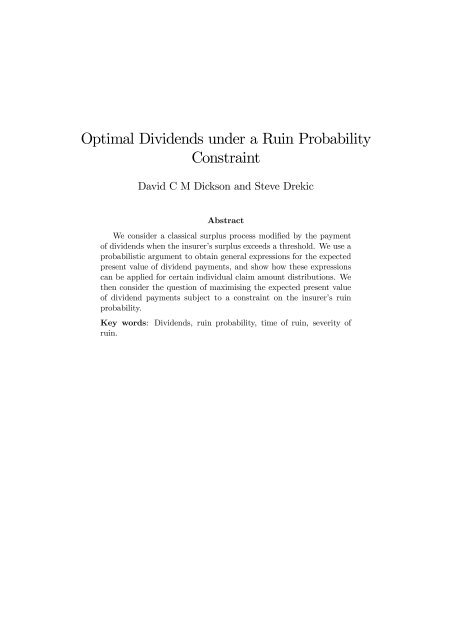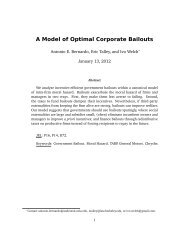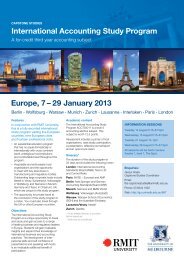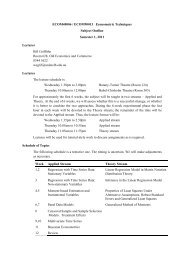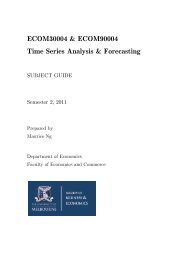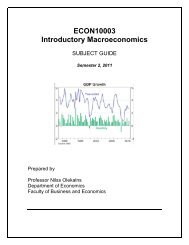Optimal Dividends under a Ruin Probability Constraint - University of ...
Optimal Dividends under a Ruin Probability Constraint - University of ...
Optimal Dividends under a Ruin Probability Constraint - University of ...
Create successful ePaper yourself
Turn your PDF publications into a flip-book with our unique Google optimized e-Paper software.
This equation has a unique positive solution for t (see Gerber and Shiu(1998)), and for the claim amount distributions considered in the next sectionthere is at least one negative solution. In this equation we can think <strong>of</strong> δ asthe Laplace transform parameter in φ, but we can also think <strong>of</strong> δ as a force<strong>of</strong> interest, and we will use this interpretation in the next section.We now introduce the dividends modification. We assume that when thesurplus process is above level b, the insurer pays dividends to shareholders atrate ĉ. Specifically, we assume in Section 2 that c − ĉ > λµ, as this conditionguarantees that ruin for our modified surplus process does not occur withprobability one. Gerber and Shiu (2005) have considered this modified surplusprocess and, by solving differential equations, have derived expressionsfor the expected present value <strong>of</strong> dividend income to shareholders when claimshave an exponential or a mixed exponential distribution. Lin and Pavlova(2005) also consider this model and define and study the Gerber-Shiu function.In the next section we will provide an alternative method, based onprobabilistic arguments, <strong>of</strong> finding explicit solutions for the expected presentvalue <strong>of</strong> dividend payments to shareholders. We illustrate ideas using exponentialand mixed exponential claim amount distributions, but the techniquecan be applied to other distributions as well.In much <strong>of</strong> the literature on dividend problems, the focus is on maximisingthe expected present value <strong>of</strong> dividend payments to shareholders. See, forexample, Gerber and Shiu (2004), Dickson and Waters (2004) and referencestherein. In Section 3, we retain this focus, but impose a constraint. Inparticular, we consider maximising the expected present value <strong>of</strong> dividendpayments to shareholders subject to a prescribed level <strong>of</strong> ruin probability. Wepresent some numerical illustrations and make comparisons with situationsin which there is no such constraint. The idea <strong>of</strong> a constraint is not new.Paulsen (2003) considered a finite time ruin probability constraint while usinga diffusion process to model the insurer’s surplus. His constraint applied fromthe time at which dividends first became payable, whereas we shall apply ourconstraint at time 0.2 <strong>Dividends</strong>In what follows we assume that dividends are payable at rate ĉ when thesurplus level is above b, with c − ĉ > λµ, and that if ruin occurs, no furtherdividends are payable. We will adapt the notation <strong>of</strong> the previous section byintroducing a hat to indicate that the insurer’s net rate <strong>of</strong> premium incomeis c − ĉ, rather than c. Thus, for example, ˆT u denotes the time <strong>of</strong> ruin for aclassical surplus process with initial surplus u and premium rate c − ĉ.3
Let V (u, b) denote the expected present value <strong>of</strong> dividend payments atforce <strong>of</strong> interest δ. For 0 ≤ u ≤ b, dividends will be payable only if the surplusprocess reaches b without ruin first occurring, so thatV (u, b) = E[exp{−δT u,b }]V (b, b)where T u,b is the time <strong>of</strong> the first upcrossing <strong>of</strong> the surplus process throughb from u without ruin occurring. See Gerber (1979, p.147).For u ≥ b, dividends are payable immediately at rate ĉ until the first timethe surplus falls below b (an event which may not occur). As this time isidentical in distribution to ˆT u−b , we can write]V (u, b) = ĉE[ā ˆTu−b+In particular,which gives∫ ∞0∫ be −δt ŵ(u − b, y, t)V (b − y, b)dydt0∫ ∞= ĉ (]) ∫ b1 − E[e −δ ˆT u−b+ e −δt ŵ(u − b, y, t)V (b − y, b)dydtδ00= ĉ (])1 − E[e −δ ˆT u−bδ∫ ∞ ∫ b+V (b, b) e −δt ŵ(u − b, y, t)E[exp{−δT b−y,b }]dydt. (2)V (b, b) = ĉ (1 − EδV (b, b) =0+V (b, b)0[e −δ ˆT 0])∫ ∞0∫ be −δt ŵ(0, y, t)E[exp{−δT b−y,b }]dydt0(])(ĉ/δ) 1 − E[e −δ ˆT 01 − ∫ ∞e ∫ 0 −δt bŵ(0, y, t)E[exp{−δT 0 b−y,b}]dydt .Hence, for 0 ≤ u ≤ b,(])(ĉ/δ) 1 − E[e −δ ˆT 0E[exp{−δT u,b }]V (u, b) =1 − ∫ ∞e ∫ 0 −δt bŵ(0, y, t)E[exp{−δT 0 b−y,b}]dydt . (3)At first sight, it appears that in order to apply formulae (2) and (3) we needto know the functional form <strong>of</strong> ŵ(u, y, t). However, as we shall see in thesubsequent analysis, this need not be the case.4
Thenso that∫ b0e αy m(y)dy =∫ b0e αy ( (α + ρ)e ρy − (α − R)e −Ry) dy= e (α+ρ)b − e (α−R)b ,L(b) = (α + ρ)e ρb − (α − R)e −Rb −( ) ( )= ρ + ˆR e ρb + R − ˆRe −Rb( ) (eα − ˆRρb − e −Rb)and henceV (u, b) = ĉ ˆRδα(α + ρ)e ρu − (α − R)e( ) ( ) −Ru.ρ + ˆR e ρb + R − ˆR e −RbConsider now the case when u ≥ b. Writing ϕ(u−b) = Eterm in formula (2) involvesϕ(u − b) =∫ ∞0e −δt ŵ(u − b, t)dt = ϕ(0)e − ˆR(u−b) .[e −δ ˆT u−b], the firstSee, for example, Gerber and Shiu (1998, equation (3.16)). Then for u ≥ b,V (u, b) = ĉ (])1 − E[e −δ ˆT u−bδ∫ ∞∫ b+ e −δt m(b − y)ŵ(u − b, t)dt f(y) V (b, b)dy00 m(b)= ĉ(b, b)(1 − ϕ(u − b)) + ϕ(u − b)Vδ m(b) α ( e ρb − e −Rb) .In particular,givesso thatV (b, b) = ĉ(b, b)(1 − ϕ(0)) + ϕ(0)Vδ m(b) α ( e ρb − e −Rb)V (b, b)m(b) α ( e ρb − e −Rb) = 1 (V (b, b) − ĉ )ϕ(0)δ (1 − ϕ(0)) ,V (u, b) = ĉϕ(u − b)(1 − ϕ(u − b)) +δ ϕ(0)= ĉδ()1 − e − ˆR(u−b)+ e − ˆR(u−b) V (b, b).6(V (b, b) − ĉδ (1 − ϕ(0)) )
For 0 ≤ u ≤ b, the value <strong>of</strong> b that maximises V (u, b) is the value <strong>of</strong> b thatminimises L(b). Thus∂(∂b L(b) = ρ + ˆR) (ρe ρb − R − ˆR)Re −Rband setting this equal to 0 gives the optimal level, b ∗ , as(b ∗ = 1 R − ˆR)Rρ + R log (ρ + ˆR) . (5)ρWe remark that the formulae for V (u, b) and b ∗ can be found in Gerber andShiu (2005).Although the exponential distribution is the most straightforward claimamount distribution to consider, one advantage it <strong>of</strong>fers is that it is the basis<strong>of</strong> De Vylder’s (1978) approximation, and Højgaard (2002) has shownthat this approximation can successfully be applied to an optimal dividendsproblem. As the solution to the problem considered in Section 3 is considerablyeasier to deal with for exponential claims than for other claim amountdistributions, De Vylder’s approximation has a certain appeal.2.2 Mixed exponential claimsLet us now consider the case when the claim amount distribution is a mixture<strong>of</strong> two exponentials withf(x) = pαe −αx + qβe −βxwhere p > 0 and p + q = 1.Following the arguments in Gerber (1979, pp.147-148) we find that, as inthe previous case,E[exp{−δT u,b }] = m(u)m(b)where we now havem(u)m(b) = ̟0(δ, b)e ρu + ̟1(δ, b)e −R 1u + ̟2(δ, b)e −R 2uwhere ρ > 0, −R 1 < 0 and −R 2 < 0 (which all depend on δ) are the solutions<strong>of</strong> Lundberg’s fundamental equation (1), i.e.λ + δ − ct = λpαα + t + λqββ + t .7
The coefficients {̟i(δ, b)} 2 i=0 satisfy the conditions1 = ̟0(δ, b)e ρb + ̟1(δ, b)e −R1b + ̟2(δ, b)e −R2b ,0 = ̟0(δ, b)α + ρ + ̟1(δ, b)+ ̟2(δ, b),α − R 1 α − R 20 = ̟0(δ, b)β + ρ + ̟1(δ, b)β − R 1+ ̟2(δ, b)β − R 2,where the final two conditions are just a special case <strong>of</strong> equation (A9) <strong>of</strong>Gerber and Shiu (2005).Considering first the case when 0 ≤ u ≤ b, in the numerator <strong>of</strong> formula(3) for V (u, b) we have]E[e −δ ˆT 0= λ ( pc − ĉ α + ˆρ +q )β + ˆρ(see Dickson (2005, p.188)) where ˆρ > 0 is the positive solution <strong>of</strong> Lundberg’sfundamental equation with premium rate c − ĉ. To find the denominator <strong>of</strong>formula (3) for V (u, b) we shall find the double integral by treating it as aspecial case <strong>of</strong> the double integral in formula (2). The starting point is thefunction φ, defined in Section 1. From Gerber and Shiu (1998), this functionsatisfies the equationwherecφ ′ (u) = (δ + λ)φ(u) − λω(u) =∫ ∞0∫ u0(6)φ(x)f(u − x)dx − λω(u) (7)e −sy f(u + y)dy= pαα + s e−αu +qββ + s e−βu .By applying standard arguments (see Gerber (1979, p.117)) we find thatφ(u) = k 0 (δ, s)e ρu + k 1 (δ, s)e −R 1u + k 2 (δ, s)e −R 2u . (8)As ρ > 0 and lim u→∞ φ(u) = 0, we must have that k 0 (δ, s) = 0. Next, wecan obtain k 1 (δ, s) and k 2 (δ, s) by inserting expression (8) for φ into equation(7). We obtain the equalities1α + s1β + s= k 1(δ, s)α − R 1+ k 2(δ, s)α − R 2,= k 1(δ, s)β − R 1+ k 2(δ, s)β − R 2,8
which givek 1 (δ, s) =αγ 1 (δ)α + s + γ β2(δ)β + s ,k 2 (δ, s) =ασ 1 (δ)α + s + σ β2(δ)β + s ,whereγ 1 (δ) = (α − R 1)(α − R 2 )(β − R 1 ),α(R 2 − R 1 )(α − β)γ 2 (δ) = − (α − R 1)(β − R 1 )(β − R 2 ),β(R 2 − R 1 )(α − β)σ 1 (δ) = − (α − R 1)(α − R 2 )(β − R 2 ),α(R 2 − R 1 )(α − β)σ 2 (δ) = (α − R 2)(β − R 1 )(β − R 2 ).β(R 2 − R 1 )(α − β)Thusφ(u) = ( γ 1 (δ)e −R 1u + σ 1 (δ)e −R 2u ) αα + s+ ( γ 2 (δ)e −R 1u + σ 2 (δ)e −R 2u ) ββ + s , (9)so that for u ≥ 0,where for i = 1, 2,w(u, y, t) = η 1 (u, t)αe −αy + η 2 (u, t)βe −βy∫ ∞0e −δt η i (u, t)dt = γ i (δ)e −R 1u + σ i (δ)e −R 2u .In the context <strong>of</strong> finding the expected present value <strong>of</strong> dividend payments,we need to evaluate∫ ∞0∫ be −δt ŵ(u − b, y, t)m(b − y)dydt09
for u ≥ b. This can be written as==∫ ∞0∫ ∞+0∫ ∞0∫ be −δt (ˆη1 (u − b, t)αe −αy + ˆη 2 (u − b, t)βe −βy) m(b − y)dydt0e −δtˆη 1 (u − b, t)dt∫ be −δtˆη 2 (u − b, t)dt0∫ bαe −αy m(b − y)dy0βe −βy m(b − y)dy() ∫ bˆγ 1 (δ)e − ˆR 1 (u−b) + ˆσ 1 (δ)e − ˆR 2 (u−b)() ∫ b+ ˆγ 2 (δ)e − ˆR 1 (u−b) + ˆσ 2 (δ)e − ˆR 2 (u−b)0αe −αy m(b − y)dy0βe −βy m(b − y)dy.The integrals in the above expression are straightforward to evaluate as m isa linear combination <strong>of</strong> three exponential functions.Then for 0 ≤ u ≤ b, we have all the components required to find]V (u, b).For u ≥ b, we require an additional component, namely E[e −δ ˆT u−b. This iseasily obtained from the above workings by noting thatφ(u)| s=0= E [exp{−δT u }I(T u < ∞)] ,so that by formulae (4) and (9), we haveE[exp{−δT u }] = (γ 1 (δ) + γ 2 (δ)) e −R 1u + (σ 1 (δ) + σ 2 (δ)) e −R 2u .We remark that, unlike in the case <strong>of</strong> exponential claims, it does not seempossible to obtain a closed form solution for the level b ∗ that maximises theexpected present value <strong>of</strong> dividend payments for given values <strong>of</strong> u and ĉ.However, it is possible to find this level numerically.2.3 An alternative approachIn the previous subsection, we derived expressions for V (u, b) both for0 ≤ u ≤ b and u ≥ b. If we are interested only in the former case, there isan alternative, more straightforward approach to finding the double integralin formula (3).From Gerber and Shiu (1998, equation (2.6)) we know thatφ(0) = λ c∫ ∞∫ ∞e −ρt e −s(y−t) f(y)dydt0t10
where ρ > 0 is the unique positive solution <strong>of</strong> Lundberg’s fundamental equation(1), and hence depends on δ. Consider a more general mixed exponentialdistribution than in the previous subsection, sayf(x) =n∑w i α i exp{−α i x}i=1where {w i } n i=1are positive weights which sum to 1. Thenφ(0) = λ c= λ c= λ cn∑∫ ∞ ∫ ∞w i α i e −ρt e −s(y−t) e −αiy dydti=10n∑∫ ∞w i α ii=1n∑α i 1w is + αi=1i0te −(ρ−s)t e−(s+α i)tdts + α iρ + α i.Thus, we havewhere for i = 1, 2, ..., n,w(0, y, t) =n∑η i (t)α i exp{−α i y}i=1∫ ∞0e −δt η i (t)dt = λ cw iρ + α i.In the case when n = 2, we thus obtain slightly simpler coefficients thanin the previous subsection, as we haveγ 1 (δ) + σ 1 (δ) = (α − R 1)(α − R 2 )α(α − β)= λ cpα + ρandγ 2 (δ) + σ 2 (δ) = − (β − R 1)(β − R 2 )β(α − β)= λ cqβ + ρ .We remark that these last two equalities also lead to formula (6) (allowingfor the different premium rate).3 <strong>Dividends</strong> <strong>under</strong> a constraintIn this section we turn our attention to the expected present value <strong>of</strong> dividendpayments subject to a ruin probability constraint. We motivate the problem11
in the following way. Suppose that the insurer is not paying dividends andhas an initial surplus which gives a ruin probability below a regulated level(e.g. the regulated level is 1%, and the insurer’s initial surplus, u, is suchthat ψ(u) = 0.005). Then the insurer is in a position to pay dividends toshareholders and still satisfy the regulations on ruin probability. For example,for u such that ψ(u) = 0.005, there is a set <strong>of</strong> pairs <strong>of</strong> dividend rate andthreshold that result in a ruin probability <strong>of</strong> 0.01. Our objective is then t<strong>of</strong>ind the optimal pair, where optimal means that the expected present value<strong>of</strong> dividend payments is maximised, subject to the constraint on the ruinprobability. We will use the notation ψ(u, b) to denote the ultimate ruinprobability when the dividend threshold is b.Our aim here is not to derive explicit solutions for optimal levels. Indeed,it is not clear that this is possible, even in the simplest situation (exponentialclaims). Rather we wish to investigate the effect <strong>of</strong> the constraint, and so allresults presented in this section have been obtained numerically, using thes<strong>of</strong>tware Mathematica. <strong>Ruin</strong> probabilities when dividends are payable havebeen calculated using results given in Dickson (1991).As a first illustration, let us consider the case when the claim amountdistribution is exponential with mean 1. We set λ = 1 and δ = 0.001, so thatwe can think <strong>of</strong> this as a force <strong>of</strong> interest <strong>of</strong> 10% per annum with 100 claimsexpected per annum. Now suppose that the premium is calculated with a20% loading, and that u = 30.7 so that ψ(u) = 0.005 (using the well-knownformula for ψ in this case). Let us further suppose that the insurer is subjectto a regulated ruin probability <strong>of</strong> ε = 0.01.In this situation, we find that the optimal combination <strong>of</strong> b and ĉ suchthat ψ(u, b) = 0.01 is b # = 49.1 and ĉ # = 0.1912, giving V (u, b # ) = 153.76.Let us compare this with two other scenarios, <strong>under</strong> each <strong>of</strong> which the insureris not subject to a ruin probability constraint. First, suppose that the insurerselects the optimal level <strong>of</strong> dividends, ĉ # = 0.1912. Then, by formula (5),the optimal threshold is b ∗ = 27.11, giving V (u, b ∗ ) = 166.46 and ψ(u, b ∗ ) =0.167. Second, suppose that the insurer simply elects to maximise V (u, b)subject to the constraint c−ĉ ≥ λµ. Then the optimal threshold is ¯b = 27.96,the optimal dividend rate is ¯c = 0.2, V (u, ¯b) = 170.5, and ψ(u, ¯b) = 1.Looking at these numbers, we can see that in the first case, for the samerate <strong>of</strong> dividend payment, the relaxation <strong>of</strong> the ruin probability constrainthas produced about an 8% increase in the expected present value <strong>of</strong> dividendpayments, but the ruin probability has increased by a factor <strong>of</strong> almost 17.The second change results in about an 11% increase in the expected presentvalue <strong>of</strong> dividend payments, while the ruin probability has increased by afactor <strong>of</strong> 100.Table 1 shows results for a range <strong>of</strong> scenarios, labelled (A) to (G). In12
Scenario u ¯b ¯c V (u, ¯b) ψ(u, ¯b)(A) 57.23 26.82 0.1 87.54 1(B) 30.70 27.96 0.2 170.50 1(C) 21.82 25.48 0.3 263.99 1(D) 49.61 26.82 0.1 84.20 1(E) 49.61 26.82 0.1 84.20 1(F) 57.23 15.01 0.1 46.39 1(G) 57.23 9.24 0.1 31.88 1Table 3: Levels <strong>under</strong> the constraint c − ĉ ≥ λµ.<strong>of</strong> u, there is no relationship between the threshold and initial surplus asthere is in Table 1. In each scenario the expected present value <strong>of</strong> dividendpayments is greater than in Table 1, since b ∗ is the optimal threshold.In Table 3 we see that the optimal dividend level is always equal to thepremium loading factor, which results in certain ruin. The expected presentvalue <strong>of</strong> dividend payments is greater <strong>under</strong> each scenario than in Table 2,and hence <strong>under</strong> Table 1.Thus, the changes as we move from Table 1 to Table 3 result in bothincreased ruin probabilities and increased expected present values <strong>of</strong> dividendpayments. Scenario (C) is perhaps the most interesting. Here we see thatthe expected present values in Tables 2 and 3 are respectively 3% and 4.2%greater than in Table 1, while the ruin probabilities have increased by factors<strong>of</strong> 9.9 and 100. It is interesting that relaxing the ruin probability constraintbenefits the shareholders so little in this scenario.As a second illustration, we consider the situation when the claim amountdistribution ( is a mixed exponential distribution with f(x) = 2 3 (2e−2x ) +1 1 e−x/2) so that µ = 1. Table 4 shows values for the same scenarios as in3 2Table 1, and we observe a similar pattern as in Table 1. However, in this casethe calculations are not as straightforward as those for Table 1. In particular,the solutions <strong>of</strong> Lundberg’s fundamental equation do not exist in a neat closedform as they do when the claim amount distribution is exponential. Table 5shows the values we obtain when we use De Vylder’s approximation to thesurplus process, resulting from the same simple calculations that produceTable 1. These approximations are remarkably good, suggesting that incases where explicit solutions for V (u, b) exist, at the very least the use <strong>of</strong>De Vylder’s approximation provides an excellent indication <strong>of</strong> the levels <strong>of</strong>the optimal pair (b # , ĉ # ) and V (u, b # ).14
Scenario c δ u ψ(u) ε V (u, b # ) b # ĉ #(A) 1.1 0.001 87.29 0.005 0.01 51.87 111.77 0.0812(B) 1.2 0.001 47.49 0.005 0.01 143.28 72.31 0.1870(C) 1.3 0.001 34.17 0.005 0.01 241.42 57.04 0.2897(D) 1.1 0.001 75.61 0.01 0.025 55.10 93.07 0.0813(E) 1.1 0.001 75.61 0.01 0.05 63.90 76.34 0.0815(F) 1.1 0.002 87.29 0.005 0.01 21.14 100.01 0.0682(G) 1.1 0.003 87.29 0.005 0.01 12.77 92.22 0.0575Table 4:claims.<strong>Optimal</strong> levels and expected present values, mixed exponentialScenario c δ u ψ(u) ε V (u, b # ) b # ĉ #(A) 1.1 0.001 87.25 0.005 0.01 51.88 111.72 0.0812(B) 1.2 0.001 47.41 0.005 0.01 143.32 72.20 0.1870(C) 1.3 0.001 34.07 0.005 0.01 241.52 56.85 0.2898(D) 1.1 0.001 75.58 0.01 0.025 55.11 93.04 0.0813(E) 1.1 0.001 75.58 0.01 0.05 63.90 76.32 0.0815(F) 1.1 0.002 87.25 0.005 0.01 21.14 99.98 0.0683(G) 1.1 0.003 87.25 0.005 0.01 12.77 92.20 0.0575Table 5: De Vylder approximations to values in Table 4.4 Concluding remarksAlthough our analysis in Section 2 involved the defective density w(u, y, t)we did not need to find its explicit form, although we did identify its generalform for the examples considered. It is possible to identify the explicit form<strong>of</strong> w(u, y, t) for certain claim amount distributions, particularly when u = 0,and this will be discussed in a forthcoming manuscript.References[1] De Vylder, F. (1978) A practical solution to the problem <strong>of</strong> ultimate ruinprobability. Scandinavian Actuarial Journal, 114-119.[2] Dickson, D.C.M. (1991) The probability <strong>of</strong> ultimate ruin with a variablepremium loading - a special case. Scandinavian Actuarial Journal, 75-86.[3] Dickson, D.C.M. (2005) Insurance Risk and <strong>Ruin</strong>. Cambridge <strong>University</strong>Press, Cambridge.15
[4] Dickson, D.C.M. and Waters, H.R. (2004) Some optimal dividends problems.ASTIN Bulletin 34, 49-74.[5] Gerber, H.U. (1979) An Introduction to Mathematical Risk Theory. S.S.Huebner Foundation, Philadelphia, PA.[6] Gerber, H.U. and Shiu, E.S.W. (1998) On the time value <strong>of</strong> ruin. NorthAmerican Actuarial Journal 2, 1, 48-72.[7] Gerber, H. U. and Shiu, E. S. W. (2004) <strong>Optimal</strong> dividends: analysiswith Brownian motion. North American Actuarial Journal 8, 1, 1-20.[8] Gerber, H.U. and Shiu, E.S.W. (2005) On optimal dividend strategies inthe compound Poisson model. Unpublished manuscript.[9] Højgaard, B. (2002) <strong>Optimal</strong> dynamic premium control in non-life insurance.Maximising dividend pay-outs. Scandinavian Actuarial Journal,225-245.[10] Lin, X.S. and Pavlova, K. (2005) The compound Poisson risk model witha threshold dividend strategy. Unpublished manuscript.[11] Paulsen, J. (2003) <strong>Optimal</strong> dividend payouts for diffusions with solvencyconstraints. Finance and Stochastics 7, 457-473.David C M DicksonCentre for Actuarial StudiesDepartment <strong>of</strong> Economics<strong>University</strong> <strong>of</strong> MelbourneVictoria 3010Australiaemail: dcmd@unimelb.edu.auSteve DrekicDepartment <strong>of</strong> Statistics andActuarial Science<strong>University</strong> <strong>of</strong> WaterlooWaterloo, OntarioCanada N2L 3G1email: sdrekic@math.uwaterloo.ca16


